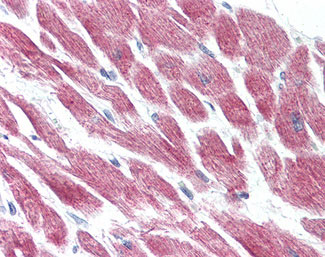BOB / GPR15 Antibody (Extracellular Domain)
Rabbit Polyclonal Antibody
- SPECIFICATION
- CITATIONS
- PROTOCOLS
- BACKGROUND

Application
| IHC-P |
|---|---|
| Primary Accession | P49685 |
| Reactivity | Human |
| Host | Rabbit |
| Clonality | Polyclonal |
| Calculated MW | 41kDa |
| Dilution | IHC-P (10 µg/ml) |
| Gene ID | 2838 |
|---|---|
| Other Names | G-protein coupled receptor 15, Brother of Bonzo, BoB, GPR15 |
| Target/Specificity | Human GPR15. BLAST analysis of the peptide immunogen showed no homology with other human proteins. |
| Reconstitution & Storage | Long term: -70°C; Short term: +4°C |
| Precautions | BOB / GPR15 Antibody (Extracellular Domain) is for research use only and not for use in diagnostic or therapeutic procedures. |
| Name | GPR15 |
|---|---|
| Function | G protein-coupled receptor that plays an important role in immune homeostasis (PubMed:33758080, PubMed:38918398). Acts via its natural ligand GPR15LG, a chemokine-like polypeptide strongly expressed in gastrointestinal tissues. GPR15-GPR15LG signaling axis regulates intestinal homeostasis and inflammation through the migration of immune cells (PubMed:33758080, PubMed:38918398). Controls thereby the specific homing of T-cells, particularly FOXP3+ regulatory T-cells (Tregs), to the large intestine lamina propria (By similarity). Also required for skin localization of thymus-derived dendritic epidermal T-cells (By similarity). Plays an important role in mediating cytoprotective function as well as angiogenesis of thrombomodulin (By similarity). Mechanistically, preferentially signals through the Gi/o pathway to inhibit adenylate cyclase activity and activate a phosphatidylinositol- calcium second messenger system that regulates the release of Ca(2+) ions from intracellular stores (PubMed:35510660). |
| Cellular Location | Cell membrane; Multi-pass membrane protein |
| Tissue Location | Highly expressed in lymphoid tissues, including macrophages and peripheral blood mononuclear cells |
| Volume | 50 µl |

Thousands of laboratories across the world have published research that depended on the performance of antibodies from Abcepta to advance their research. Check out links to articles that cite our products in major peer-reviewed journals, organized by research category.
info@abcepta.com, and receive a free "I Love Antibodies" mug.
Provided below are standard protocols that you may find useful for product applications.
Background
Probable chemokine receptor. Alternative coreceptor with CD4 for HIV-1 infection.
References
Heiber M.,et al.Genomics 32:462-465(1996).
If you have used an Abcepta product and would like to share how it has performed, please click on the "Submit Review" button and provide the requested information. Our staff will examine and post your review and contact you if needed.
If you have any additional inquiries please email technical services at tech@abcepta.com.













 Foundational characteristics of cancer include proliferation, angiogenesis, migration, evasion of apoptosis, and cellular immortality. Find key markers for these cellular processes and antibodies to detect them.
Foundational characteristics of cancer include proliferation, angiogenesis, migration, evasion of apoptosis, and cellular immortality. Find key markers for these cellular processes and antibodies to detect them. The SUMOplot™ Analysis Program predicts and scores sumoylation sites in your protein. SUMOylation is a post-translational modification involved in various cellular processes, such as nuclear-cytosolic transport, transcriptional regulation, apoptosis, protein stability, response to stress, and progression through the cell cycle.
The SUMOplot™ Analysis Program predicts and scores sumoylation sites in your protein. SUMOylation is a post-translational modification involved in various cellular processes, such as nuclear-cytosolic transport, transcriptional regulation, apoptosis, protein stability, response to stress, and progression through the cell cycle. The Autophagy Receptor Motif Plotter predicts and scores autophagy receptor binding sites in your protein. Identifying proteins connected to this pathway is critical to understanding the role of autophagy in physiological as well as pathological processes such as development, differentiation, neurodegenerative diseases, stress, infection, and cancer.
The Autophagy Receptor Motif Plotter predicts and scores autophagy receptor binding sites in your protein. Identifying proteins connected to this pathway is critical to understanding the role of autophagy in physiological as well as pathological processes such as development, differentiation, neurodegenerative diseases, stress, infection, and cancer.


